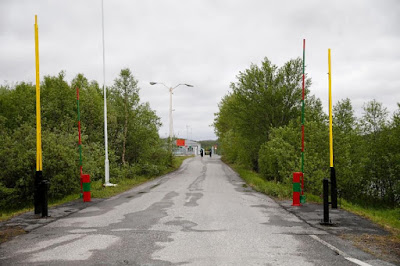Yahoo – AFP,
Pierre-Henry Deshayes, 31 Ag 2015
 |
The
Storskog Boris Gleb border crossing between Norway and Russia near the
Norwegian town of Kirkenes in the far north of the country, pictured on June 6,
2013 (AFP Photo/Conelius Poppe)
|
While
thousands of refugees fleeing the war-torn country are risking their lives by
boarding overloaded boats to cross the Mediterranean, others have chosen to fly
to Moscow before travelling north to Norway, according to Hans Mollebakken, the
police chief in the Arctic town of Kirkenes.
Some of
them may have also spent some time in Russia.
"About
150 people have crossed the border so far this year, mostly Syrians," he
told AFP Monday.
"The
numbers have really taken off this year."
Kirkenes is
about 4,000 kilometres (2,500 miles) from Damascus as the crow flies.
Temperatures in winter can regularly drop to minus 15 degrees Celsius (plus
five Fahrenheit).
In 2014,
only a dozen asylum seekers entered Norway at the Storskog border crossing,
guarding what during the Cold War used to be one of the only borders dividing
the USSR and NATO.
It is
difficult to find out why the Syrians arriving in Kirkenes chose that route.
Norway,
which is not a member of the European Union but belongs to the Schengen Area
allowing free movement of people, has a right-wing coalition government that
includes the populist anti-immigrant Progressive Party.
The
oil-rich nation has a relatively restrictive refugee policy, especially when
compared to neighbouring Sweden.
Sweden
recorded the second biggest number of asylum applications in the EU in 2014
after Germany -- 13 percent of all applicants, although as a proportion in
relation to its population size, the country is shouldering the biggest burden
in the bloc.
Dark
winters a challenge
Because the
border is closed to pedestrians, some have cleverly found a loophole by biking
into Norway.
"We
have some who have crossed by bike in the dead of winter," customs'
inspector Goran Stenseth told AFP.
"The
cold, the snow, the darkness... All of this presents a real challenge to these
people."
The
Kirkenes police have seized around 20 bikes, and issued fines up to 6,000
Norwegian kroner (around 650 euros or $800) to Russians and Norwegians who have
made a business out of driving migrants over the border for a fee.
"We
don't want these vulnerable people to be exploited," Stenseth said.
"We
are trying to figure out if they're being transported as part of an organised
trafficking ring but so far there is nothing to indicate that," he said,
noting that the Syrians were crossing alone, as families or in small groups.
"Those
who arrive here appear to be in good health and happy to arrive in
Norway," he said.
Contrary to
what may happen in other European countries, the migrants are not turned back
at the border. Once they've crossed into Norway, they are immediately
transported to Oslo where they are registered for processing.
According
to Norwegian immigration authorities, just under 1,000 Syrians have sought
asylum in the Scandinavian country since the beginning of the year.
In 2015
more than 300,000 refugees fleeing poverty and conflict in their homeland have
crossed the Mediterranean in an attempt to reach Europe. More than 2,500 died
during their crossing, according to an official count published on Friday by
the UN refugee agency.












No comments:
Post a Comment
Note: Only a member of this blog may post a comment.